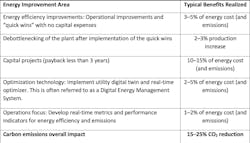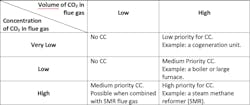Scope 1 and 2 Emission Reductions: The First Steps to Decarbonization
To achieve net zero, chemical companies must first develop a roadmap that implements Scope 1 and 2 emission reduction projects. These include energy efficiency improvements, carbon capture and storage or utilization and importing low-carbon energy sources.
In a previous column, I discussed various decarbonization opportunities. When attempting to reduce carbon emissions, consider three possible methods: Scope 1 emissions reduction (reducing emissions from operations), Scope 2 emissions reduction (importing low carbon fuel sources), and Scope 3 emissions reduction (producing net-zero products by importing green feedstock sources). To reach net zero, a typical strategy starts by reducing Scope 1 and Scope 2 emissions before attacking Scope 3 reductions separately. Scope 3 reductions depend on market demands, regulations and government subsidies (see my previous article explaining the Inflation Reduction Act).
The first step is saving energy. Based on my experience working in oil refineries and petrochemical plants, chemical manufacturers can achieve energy savings via several initiatives. Table 1 shows the typical order in which tasks are executed.
Other projects to cut Scope 1 emissions emerge from furnaces, boilers, gas turbines and any additional fuel engines. Flue gasses from these units contain varying amounts and concentrations of CO2. The current approach to reducing emissions, often seen in Europe and Asia, is to implement a carbon capture unit (CCU) and use it as a feedstock for certain products, or store or export the CO2 recovered (carbon capture storage (CCS)).
While future columns will explore opportunities for CCS and CCU, building and operating these processes using current technologies is cost-prohibitive. However, placing a cost on CO2 emissions (like in Europe or California) may incentivize companies to improve the situation. Furthermore, subsidies for emission reductions or a price-per-ton of CO2 stored underground will eventually make these processes profitable. Another example includes oil-producing areas, such as the Permian Basin in Texas, where reinjecting CO2 in oil wells can generate more oil for enhanced oil recovery.
To select the best carbon-capture (CC) processes, consider the parameters in Table 2. Future columns will focus on the latest CC technologies.
Compared to Scope 1, reducing Scope 2 emissions is more straightforward. Scope 2 emissions are attributed to imported energy sources, such as renewable power or green or blue hydrogen. Recent declines in renewable energy prices and solar and wind farm installation costs typically accelerate meeting emission reduction targets.
This all depends on whether renewable energy is available at the plant location. When the plant is in an industrial complex that can share costs and benefits with other factories, developing a large-scale renewable energy facility that supplies the whole area may be advantageous. An example is the plan by the Port of Rotterdam in the Netherlands to install a 1 GW electrolyzer to produce green hydrogen for that area.
Collectively, these projects in Scopes 1 and 2 can potentially slash emissions from 30% to 50% in 10–15 years, putting us on track to realize 100% reduction by the year 2050.
About the Author
Michiel Spoor, Energy Saver columnist
Energy Saver columnist
Michiel Spoor has over 28 years of energy experience, working worldwide as a leader in oil and gas consulting. He has a master’s degree in Chemical Process Technology from the Delft University of Technology in The Netherlands.
His passion is to shape the future of energy transition, renewables, global carbon emission reduction and energy efficiency. He has had diverse roles in engineering and consulting. He started his career as a process design engineer at Badger BV in The Hague where he brought plants from conceptual design, through process simulation, equipment designs all the way to commissioning and start-up.
As a consultant Michiel specializes in energy management and energy transition and has held senior positions in various companies like KBC, Accenture and KBR. Currently Michiel works as a Principal Consultant Energy with KBC Advanced Technology in Houston, Texas. He has worked on six continents on various projects and positions in oil refining, petrochemicals, fertilizers, LNG and renewables.
Michiel has authored and contributed to numerous papers and conferences on the topics of refinery energy efficiency and refinery carbon management. He is internationally recognized as an authority on this subject.



